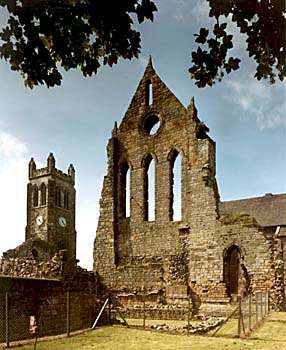 I was repairing a lost bookmarks list and it caused me to visit a blog or two I have not read in, well, a year or more. One had an interesting question about what some future archeologist might surmise by the ruins of your church building. It was more than intriguing for me to begin imagining someone digging through the remains of the churches I have served.
I was repairing a lost bookmarks list and it caused me to visit a blog or two I have not read in, well, a year or more. One had an interesting question about what some future archeologist might surmise by the ruins of your church building. It was more than intriguing for me to begin imagining someone digging through the remains of the churches I have served. I would guess that they would see the centrality of baptism, preaching, and the Eucharist since in all three these pieces of liturgical furniture are substantial and would survive mostly in tact a good long time. He would see the shards of stained glass -- all symbols easily identifiable with the Christian faith -- the Trinity, means of grace, vine and branches, etc... He would find pipes from the organ and know that music was central to the cultus of this congregation. He would find statues and a couple of crucifixes (crucifii) and know that the central preaching of this place was Jesus Christ and Him crucified (as Paul says). He would find precious metals shaped into chalices, ciboria, paten, and the like and know that these were highly esteemed for their usefulness in the Divine Service. He would find candelabra and figure that light was highly symbolic in this faith and worship. He would find remnants of vestments (copes to chasubles to capa negra to albs to cassocks to cottas to surplices to stoles to a biretta or two) and would see how the priests had their personal identity covered by the clothing that points to Christ. I could go on and on -- some of the things might be less than significant, from the number of toilets in the building to the size of the coffee pots!
I also began to think what other styles of buildings might betray of their tenants and tenets. Alas, with comfortable seating and a stage, big screens and a trap set, it might be hard to distinguish some from either a theater, movie theater, or nightclub. It occurred to me that some might be hard to differentiate from lecture halls or academic buildings with their central pulpits or lecterns and chairs arranged as one might a giant lecture hall. It might seem that for some structures worship was all about words and little else. For others, it might appear that worship involved entertainment with soloists and musicians to play and make merry. In any case it is not a bad thing to stop every now and then and ask ourselves what our worship facilities actually reveal about what we think of worship. Maybe, just maybe, it might cause us to be a bit more cautious about adopting the latest trend of music or culture or fashion. But, then again, I might just be presuming too much about the kind of legacy we think we are leaving... In the end, the greater tragedy would be if our buildings told a big story about us but left the God we worship a mystery, unknown and without hint in the ruins of the structures in which the people of God once gathered.... Just sayin....
3 comments:
What do we think about worship? There is an LCMS-sponsored "Spiritual But Not Religious" workshop available:
http://steadfastlutherans.org/?p=23203
It must be good, because an LCMS district president endorses it! (Sarcasm intended.) Soon, all of the LCMS pastors in the California-Nevada-Hawaii District will be promoting Labyrinth Spirituality!
Is this coming to your district anytime soon, Rev. Peters?
Looks like archaeologists working in the ancient Clarksville site will dig up: Theaters. Here we have churches that meet in actual theaters, church buildings that look like theaters. Oh, and the artifacts of worship? I guess jumbotrons will give the clue that our church buildings were theaters, too.
I am thankful for a modern building with good acoustics, technology (aka HVAC, microphones, etc.), and indoor plumbing.
I think if the Lord tarries however, and our building should be dug up in a couple thousand years, the statuary, pulpit/lectern, remaining fragments of paraments,chancel, sacristy, vestry (also with fabric fragments), and an altar surrounded by Christian symbols, and with a Lectionary upon it, they'll believe they have an ancient Christian church building on site. (Sorry for the run-on sentence, but St. Paul did it, too.)
Centuries from now, archeologists will dig up many old churches and wonder why some have altars, while others do not.
Post a Comment